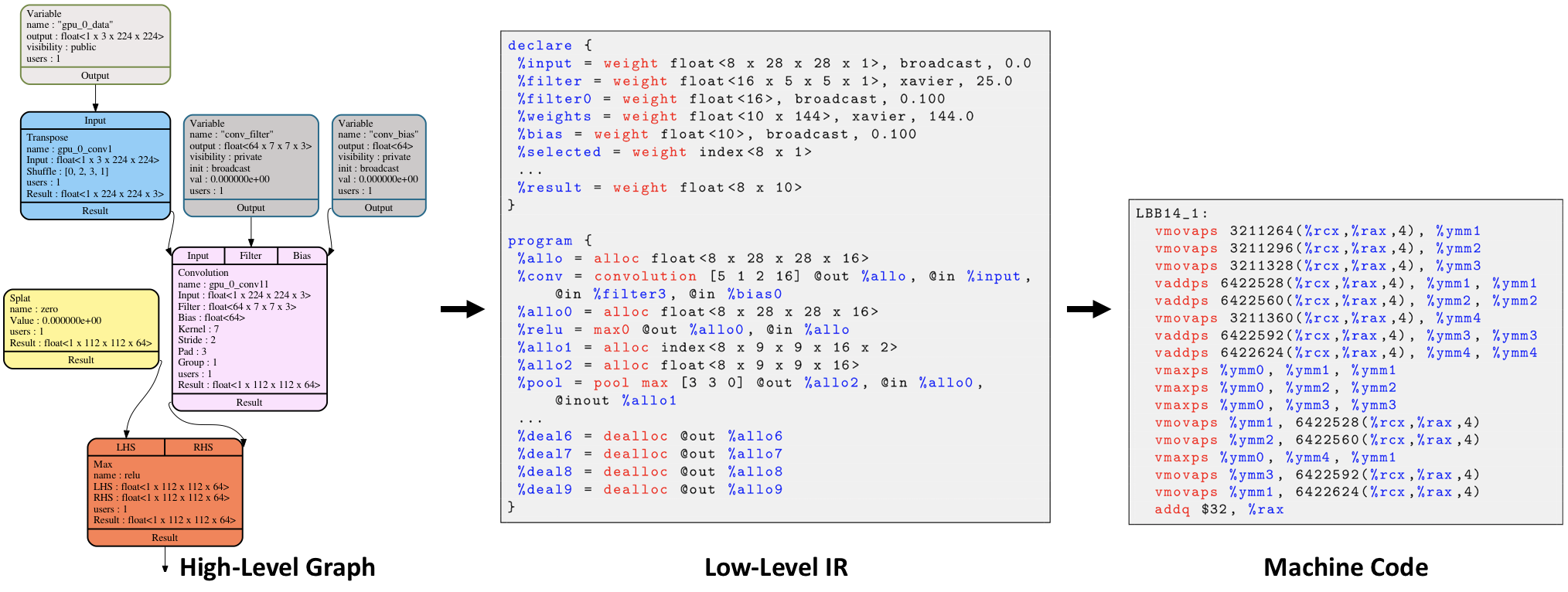Glow is a machine learning compiler and execution engine for various hardware targets. It is designed to be used as a backend for high-level machine learning frameworks. The compiler is designed to allow state of the art compiler optimizations and code generation of neural network graphs. This library is in active development.
Glow lowers a traditional neural network dataflow graph into a two-phase strongly-typed intermediate representation (IR). The high-level IR allows the optimizer to perform domain-specific optimizations. The lower-level instruction-based address-only IR allows the compiler to perform memory-related optimizations, such as instruction scheduling, static memory allocation and copy elimination. At the lowest level, the optimizer performs machine-specific code generation to take advantage of specialized hardware features. Glow features a lowering phase which enables the compiler to support a high number of input operators as well as a large number of hardware targets by eliminating the need to implement all operators on all targets. The lowering phase is designed to reduce the input space and allow new hardware backends to focus on a small number of linear algebra primitives. The design philosophy is described in an arXiv paper.
Glow builds and runs on macOS and Linux. The software depends on a modern C++ compiler that supports C++11, on CMake, LLVM, protocol buffers, and libpng.
git clone git@github.com:pytorch/glow.git # or: git clone https://github.com/pytorch/glow.git
cd glowGlow depends on a few submodules: googletest, onnx, and a library for FP16 conversions.
To get them, from the glow directory, run:
git submodule update --init --recursiveInstall the required dependencies using Homebrew:
brew install cmake graphviz libpng ninja protobuf wget
brew install --with-toolchain llvm@6Note that LLVM is installed to a non-default location (/usr/local/opt/llvm) to
avoid conflicts with the system's LLVM.
On Ubuntu you would need to install a few dependencies. The following command should install the required dependencies.
sudo apt-get install graphviz clang cmake wget ninja-build llvm-5.0 \
libprotobuf-dev protobuf-compiler libpng-devIn order to support ONNX net serialization format, Glow requires
protobuf >= 2.6.1, but the above command may install older
version on older Ubuntu (e.g. 14.04). If this is the case, we suggest to look
at utils/install_protobuf.sh to install newer version from source.
Note, that OpenCL support is not trivial on Linux. We suggest to build without OpenCL for the first time.
To build the compiler, create a build directory and run cmake on the source directory. It's a good idea to build two configurations (Release and Debug) because some programs take a really long time to run in Debug mode. It's also a good idea to build the project outside of the source directory.
mkdir build_Debug
cd build_Debug
cmake -G Ninja -DCMAKE_BUILD_TYPE=Debug ../glow
ninja allIt's possible to configure and build the compiler with any CMake generator, like GNU Makefiles, Ninja and Xcode build.
By default, Glow will use a system provided LLVM. Note that Glow requires LLVM
5.0 or later. If you have LLVM installed in a non-default location (for
example, if you installed it using Homebrew on macOS), you need to tell CMake
where to find llvm using -DCMAKE_PREFIX_PATH. For example:
cmake -G Ninja ../glow \
-DCMAKE_BUILD_TYPE=Debug \
-DCMAKE_PREFIX_PATH=/usr/local/opt/llvmIf LLVM is not available on your system you'll need to build it manually. Run
the script '/utils/build_llvm.sh to clone, build and install LLVM in a local
directory. You will need to configure Glow with the flag -DCMAKE_PREFIX_PATH
to tell the build system where to find LLVM (e.g. the location of
llvm_install/ if using build_llvm.sh).
For more platform-specific build instructions and advanced options, such as building with Address-Sanitizers refer to this guide: Building the Compiler.
The project has a few unit tests in the tests/unittests subdirectory. To run all
of them, simply run ninja test.
A few test programs that use Glow's C++ API are found under the examples/
subdirectory. The mnist, cifar10, fr2en and ptb programs train and run digit
recognition, image classification and language modeling benchmarks,
respectively.
To run these programs, build Glow in Release mode, then run the following commands to download the cifar10, mnist and ptb databases.
python ../glow/utils/download_test_db.py --allNow run the examples. Note that the databases should be in the current working directory.
./bin/mnist
./bin/cifar10
./bin/fr2en
./bin/ptb
./bin/char-rnnIf everything goes well you should see:
mnist: pictures from the mnist digits databasecifar10: image classifications that steadily improvefr2en: an interactive French-to-English translatorptb: decreasing perplexity on the dataset as the network trainschar-rnn: generates random text based on some document
Note that the default build mode is Debug, which means that the compiler
itself is easy to debug because the binary contains debug info, lots of
assertions, and the optimizations are disabled. It also means that the compiler
and runtime are very slow, and the execution time can be hundreds of times
slower than that of release builds. If you wish to benchmark the compiler, run
long benchmarks, or release the product then you should compile the compiler in
Release mode. Check the main CMake file for more details.
More details on testing and running Glow can be found in: Testing the Glow Compiler.
Glow can be used to compile neural networks into object files containing native
code. We provide resnet50 (both quantized and non-quantized versions) as an
example of this capability in examples/bundles/resnet50. See Creating
Standalone Executable Bundles for more detail.
To get started, please refer to the following guides:
- forums: discuss implementations, research, etc. http://discuss.pytorch.org. Make sure to label topic with the "glow" category.
- GitHub issues: bug reports, feature requests, install issues, RFCs, thoughts, etc.
Glow is licensed under the Apache 2.0 License.

